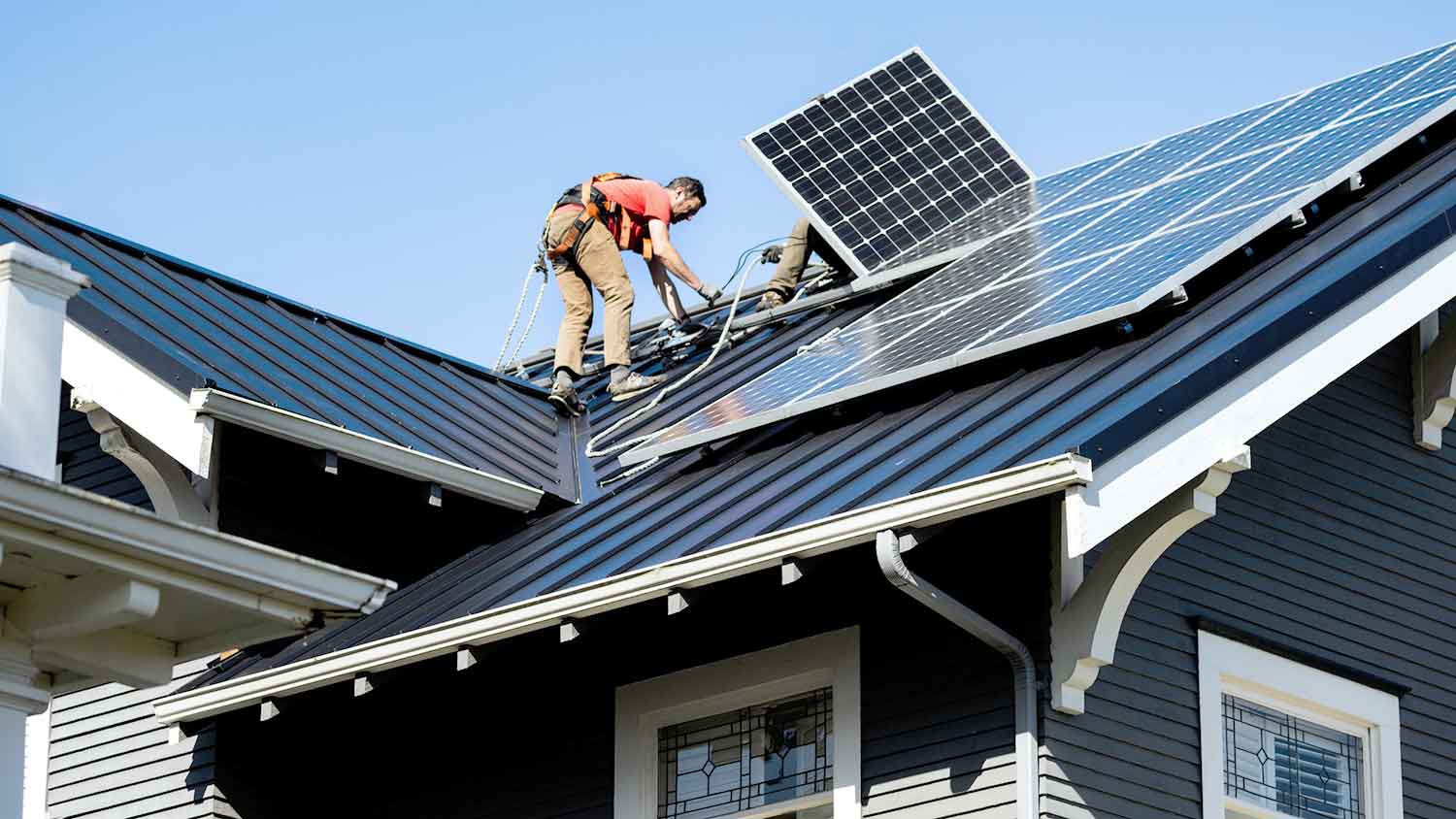
Solar panel inspection costs vary depending on the size, location, type, and add-on work required. Use this breakdown of price factors to estimate your cost.
Reduce your tax bill while boosting your home’s energy efficiency


Federal solar tax credits let you claim 30% of the cost of a solar system as a tax credit.
You have until 2035 to install your system and claim credit.
You must own your solar system and claim credit the year it becomes operational.
Combine federal credits with utility rebates, net metering, state credits, and renewable energy credits to maximize savings.
Looking to power up your savings while powering your home with renewable energy? If you’re a homeowner considering solar, now is a great time to take advantage of federal solar tax credits. Switching to solar with this credit can save thousands on a solar panel installation. Here’s everything you need to know about how solar tax credits work, who qualifies, and how to tap into this valuable incentive.
According to Energy Star, the federal solar tax credit, or Investment Tax Credit (ITC), lets taxpayers claim up to 30% of the cost of a photovoltaic (PV) solar energy system as a credit on their federal tax returns. It offers a major financial incentive to switch from fossil fuels to renewable energy systems.
If you choose a renewable energy system for your home—like solar panels, solar water heaters, wind turbines, or geothermal heat pumps—you can save money through the Residential Clean Energy Credit. According to the Internal Revenue Service (IRS), the program offers a tax credit of up to 30% of the costs of certain clean energy systems installed in homes.
Tax credits for both programs were originally set to expire in 2022, but, as the White House Inflation Reduction Act Guidebook explains, they now last through 2034. However, the credit percentage for both programs will drop to 26% in 2033 and 22% in 2034 before phasing out entirely in 2035. So, you’ll need to install your renewable energy system by 2032 to claim the full credit.
Solar tax credits are a dollar-for-dollar reduction of your federal taxes. This is more valuable than deductions—which reduce taxable income, whereas tax credits directly lower the amount you owe for a given year—or rebates, which some solar dealers account for by raising sticker prices.
Some kinds of solar panel ROI, like energy savings and increased home value, take time. But the solar tax credit applies to your taxes the same year you install your panels, which can help offset initial costs and solar panel financing.
There is no maximum dollar limit to the tax credits. Additionally, if the tax credit exceeds the taxes you owe for the year you install your solar energy system, you can roll over the unused portion to future tax years.

To qualify, you must own the solar energy system, not rent it. You will not qualify if you lease your solar panels or sign a power purchase agreement like those outlined by the U.S. Department of Energy.
The solar installation must be installed and used at your primary residence for full credit. All types of dwellings qualify, including homes, houseboats, and solar panels on mobile homes. If you install a solar array on a vacation home, secondary home, or rental property, you may qualify for partial credit.
You can only claim the credit for the year your system becomes operational. For example, if you hire a local solar panel company to install your system in 2024 but don’t activate it until 2025, you can claim the credit on your 2025 tax return.
The federal solar tax credit for homeowners applies to more than just solar panels, including the following:
Solar panels and related equipment, including inverters, wiring, and mounting hardware
Other renewable energy systems including wind and geothermal for homes
Labor costs for installation, including permit and inspection fees
Energy storage systems, including batteries, with a capacity of at least 3 kilowatt-hours (kWh)
Sales tax on eligible expenses
Expenses that do not qualify include roof repairs or replacement, tree trimming, and upgrades to roofing components like trusses and shingles—unless they specifically help with solar energy generation. Installing solar shingles would apply, but replacing traditional shingles would not.
Before installing solar, check the age and condition of roof shingles. If your roof is 20 years or older, you might want to consider replacing the roofing before installing the solar panels.
Federal solar tax credits allow homeowners and businesses to deduct 30% of the cost of solar and other renewable energy systems from their federal taxes. On average, solar panel installations in the U.S. cost between $20,000 and $30,000, which means homeowners save between $6,000 and $9,000 on average with the current renewable energy tax credits.
The installation of solar panels and other types of renewable energy systems can boost your investment right away with tax savings. Considering additional long-term energy savings, solar panel installation could be worth it for your home.
Along with federal solar tax credits, you can benefit from state and local incentives, including rebates and exemptions. Additionally, many utility companies offer net metering that credits you for excess electricity your solar system generates and sends back to the grid. You can also sell renewable energy certificates (RECs) in some areas.
Here are additional ways to save when you install solar:
Utility rebates: Utility companies sometimes offer rebates on the cost of your solar installation.
Net metering: You might be able to get credit for excess energy that your solar system generates and exports to the local grid.
State tax credits: Many states offer solar tax credits separate from federal credits.
RECs: Earn money from renewable energy certificates for electricity your solar panels generate.
You’ll need to complete IRS Form 5695 for Residential Energy Credits and include it with your federal tax return for the year you install your system. If a tax professional files your taxes for you, tell them about your solar installation and ask if you qualify for state and federal tax credits.
No, squeaky floors do not always indicate structural damage related to a shifting foundation or subfloor damage. However, they may indicate underlying issues like loose subflooring, joists, or floorboards. While many squeaks are harmless, persistent noise could point to more severe problems besides being extremely annoying. It's always best to have a professional inspect your floor to determine the root of the issue.
Yes, carpenters can fix squeaky floors. They have the expertise to identify the source of the squeak, whether it’s loose floorboards, subfloor issues, or joist problems. These experts also have the right tools and hands-on knowledge to secure the flooring and eliminate the noise, ensuring a long-lasting solution.
While it may not always be ideal, you can fix a squeaky floorboard without removing the carpet. Pros use specialized carpet screws and drive them through the carpet into the subfloor, securing floorboards. They may also use nails instead of screws if they suspect the pile will get caught in the screw. While some types of carpet will hide the screws and nails, a low-pile carpet may not.
From average costs to expert advice, get all the answers you need to get your job done.

Solar panel inspection costs vary depending on the size, location, type, and add-on work required. Use this breakdown of price factors to estimate your cost.

Get a clear estimate for solar water heater repair cost. Learn what impacts pricing and how to budget for your solar water heater repair.

Solar battery costs depend on the size of your system, labor, and capacity. Learn how much you could pay for batteries for home solar systems.

Installing solar panels helps you save on energy bills while adding value to your home. Here’s a look at solar panel ROI and what makes them attractive to buyers.

There are three types of solar panels: monocrystalline, polycrystalline, and thin-film. Before choosing one for your home, here are the pros and cons of each.

Whether you’re building or buying, you might be wondering who to hire for a solar panel inspection for a new home. We have the answer.